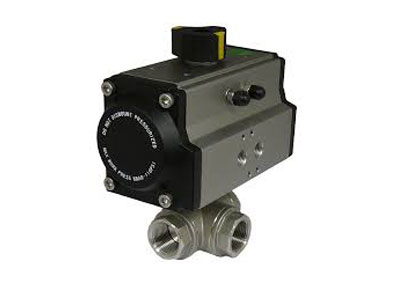What Is The Working Principle Of A Valve?
Key Takeaway
The working principle of a valve is to control the flow of fluids, such as gases or liquids, within a system. Valves function by opening, closing, or partially obstructing pathways to regulate the flow based on pressure, temperature, or other conditions.
For example, a ball valve uses a rotating ball with a hole that aligns with the pipe to allow flow or blocks it when the ball is rotated. Control valves adjust flow by responding to signals that regulate pressure and ensure a desired flow rate. Pneumatic valves work by using air pressure to push a diaphragm or piston, which moves a stem to either open or close the valve. Actuated valves can be manually or remotely controlled using electric, pneumatic, hydraulic, or spring mechanisms. Valves are crucial in various industries, including water treatment, chemical processing, and power plants, ensuring safe and efficient operation.
Fundamental Principles Behind Valve Operations
At the core of valve operations is the concept of controlling flow. Valves function by regulating the passage of fluids, whether they are liquids, gases, or even granular materials like powders. The most basic function of a valve is to open or close the flow path to allow or block the flow, or to adjust the flow rate as needed.
This process typically involves the movement of a valve element such as a ball, disc, or plug, which either opens or obstructs the flow path. The action of opening or closing a valve can be done manually, pneumatically, or electrically, depending on the system’s requirements. The control mechanism behind these movements is often a mechanical actuator that responds to changes in pressure, temperature, or flow rate.

Key Components That Affect Valve Function
Several components play a critical role in the operation of a valve. The primary ones include:
1. Valve Body: The main structure that houses the internal components and provides the flow passage.
2. Valve Seat: The surface against which the valve element seals to block the flow.
3. Valve Element: This is the component (like a ball or plug) that moves to open or close the valve.
4. Actuator: The device responsible for moving the valve element. Actuators can be manual (hand wheels), pneumatic, or electric, depending on the application.
5. Stem: The shaft connecting the actuator to the valve element, allowing for precise control of the valve’s movement.
Each component affects the performance and reliability of the valve. For instance, the material of the valve body and seat determines its durability and suitability for certain environments, such as high-pressure or corrosive applications.
Different Types of Valves and Their Principles
Valves come in various types, each designed to meet specific needs based on flow control, pressure regulation, or directional flow. The principles behind each type differ slightly depending on their intended function.
1. Gate Valves: These valves operate on a sliding gate mechanism to either fully block or allow flow. They are typically used for on/off control with minimal pressure drop.
2. Ball Valves: Ball valves use a rotating ball with a hole in the middle to control flow. By rotating the ball, the valve either allows or blocks the flow path.
3. Globe Valves: These have a plug mechanism that moves up and down to regulate flow, offering more precise control of flow rates.
4. Check Valves: These valves automatically prevent backflow in a system by allowing fluid to flow in only one direction.
5. Pressure Relief Valves: Used to protect systems from excess pressure, these valves open automatically when the pressure exceeds a preset limit.
Each type of valve operates on a unique principle that suits the specific requirements of fluid handling in industrial processes.
The Role of Pressure and Flow in Valve Operation
Pressure and flow are key factors that influence how a valve operates within a system. Pressure controls how much force is needed to open or close a valve, while flow determines the rate at which the fluid moves through the valve.
Pressure: A valve must be able to withstand the pressure of the fluid or gas passing through it. High-pressure applications often require more robust valve designs, such as reinforced valve bodies or special sealing materials.
Flow: The flow rate dictates how much material is allowed to pass through a valve. For example, a valve used in a cooling system must precisely control the flow of coolant to maintain consistent temperatures.
By understanding these factors, engineers can select the right type of valve for a particular system, ensuring optimal performance and preventing damage caused by overpressure or flow fluctuations.
Common Valve Mechanisms: Manual, Pneumatic, and Electric
Valves can be controlled using different mechanisms, each suited to specific needs. The three most common control mechanisms are manual, pneumatic, and electric.
1. Manual Control: The simplest method, where the valve is operated using a handwheel, lever, or knob. This method is typically used for small systems or valves that don’t need frequent adjustments.
2. Pneumatic Control: Pneumatic actuators use compressed air to operate the valve, making them ideal for systems requiring frequent operation or remote control. They are commonly used in automation and process control systems.
3. Electric Control: Electric actuators use an electric motor to move the valve. They offer precise control and are often used in complex systems where automated or remote operation is required.
Each of these mechanisms has its advantages, with pneumatic and electric systems offering more precision and control for larger, more complex systems.
Conclusion
Understanding the working principle of valves is essential for effective system design, maintenance, and troubleshooting. Valves regulate the flow of fluids, and their functionality depends on the components and mechanisms that make them operate. By recognizing how pressure, flow, and control methods impact valve performance, engineers can select the right valve for each application. Whether for manual control or automated systems, the ability to choose the correct valve ensures better system performance, efficiency, and longevity.

